Layer 4-Layer 7 Service
Cisco DCNM Release 11.3(1) introduces the ability to insert Layer 4-Layer 7 (L4-L7) service devices in a data center fabric, and also enables selectively redirecting traffic to these service devices. You can add a service node, create route peering between the service node and the service leaf switch, and then selectively redirect traffic to these service nodes.
You can also watch a video that demonstrates how to orchestrate a L4-L7 Service Appliance with a VXLAN Fabric in a data center managed by Cisco DCNM. This demo covers provisioning, defining of service policies, and monitoring of redirected flows. For information, see Video: Service Redirection in Cisco DCNM.
Service Node
You have to create an external fabric and specify that a service node resides in that external fabric during service node creation. DCNM does not auto-detect or discover any service node. You also have to specify the service node name, type, and form factor. The name of the service node has to be unique within a fabric. The service node is attached to a leaf, border leaf, border spine, or a border super spine. Starting from Cisco DCNM Release 11.4(1), the service node can be attached to a vPC border gateway also. DCNM does not define a new switch role for a service leaf.
DCNM manages the switches that are attached to a service node. DCNM also manages the interfaces of these attached switches. Ensure that the interfaces to which the service node is attached to are in trunk mode and do not belong to any interface group. The L4-L7 service will not change its mode. In case the attached switches are forming a vPC pair, the name of the attached switch is a combination of both switches.
Route Peering
Route peering creates service networks. DCNM supports both static route and eBGP-based dynamic route peering options. After you specify the service network and select the peering policy for the tenant, DCNM automatically creates the service network under the specified tenant. Note that the terms, tenant and VRF, will be used interchangeably in this guide. If you select a route peering and click Deploy in the Service Nodes window, the L4-L7 service deploys the corresponding service network and VRF configuration to the leaf that is attached to the service node. Click Preview to review both the peering and service network configuration.
The automatically created service network will also be listed on the Control > Fabrics > Networks window. You can view and edit the corresponding config parameters in the Networks window. However, you cannot delete the service network. Deletion of service networks is handled automatically during the service route peering deletion process. There can be multiple route peerings defined per tenant/VRF.
Service Policy
From DCNM 11.5(1), you can define service policies with any or arbitrary network and associate it with L3 routed interface on border switches. For more information, see PBR Support on WAN Interfaces of Border Switches. The L4-L7 service does not create any VRF or network other than the service networks that are defined during route peering. When you define the service policy between the created networks, the source and destination network can be a subnet, an individual IP address or the networks that are defined in the Control > Fabrics > Networks window. For intra-tenant firewall, one-arm and two-arm load balancer, the L4-L7 service in DCNM uses Policy-Based Routing (PBR) for service insertion. The inter-tenant firewall does not have a service policy. You only need to create a service node and route peering for inter-tenant firewall.
As the source and destination network can be attached or deployed independent of service policy deployment, the tenant/ VRF-related service policy configuration is only attached or pushed to the switch that is attached to the service node, and the source and destination network is updated with the service policy-related configuration. You can preview and confirm the generated configuration. By default, the service policy is defined but is not enabled or attached. You have to enable or attach the service policy to activate it.
The service configuration that is related to the source and destination network will be auto-processed when the source and destination networks are to be attached, or auto-updated in case the networks are already attached or deployed. By default, DCNM will collect statistics every 5 minutes and store it in ElasticSearch for aggregation and analysis. Click the graph line under Stats in the Service Policy tab of the Service Nodes window to view the historical time-based statistics. By default, the statistics are stored for a maximum of 7 days.
The service insertion is effective only on the flows to be created. There is no impact on any existing flows. Deletion of a network is not allowed in case an enabled service policy is associated with that network.
The L4-L7 service integration is built on top of the easy fabric policy enforcement. Use the fabric builder to create a VXLAN EVPN fabric and then import Cisco Nexus 9000 Series switches into the fabric with pre-defined fabric policies.
MSD Support
Starting from Cisco DCNM Release 11.4(1), this feature supports Multi-Site Domains (MSD). Select the MSD member fabric from the DCNM fabric scope selector, create a service node (for example, firewall, or load balancer), attach the service node to the switch in the selected MSD member fabric, define the route peering and service policies, and deploy relevant configurations on the selected MSD member fabric. For more information on the procedure to configure Layer 4-Layer 7 service, refer Configuring Layer 4-Layer 7 Service.
RBAC Support
Starting from Cisco DCNM Release 11.4(1), the Layer 4-Layer 7 Service supports Role-Based Access Control (RBAC) along with fabric access mode.
The admin, stager, and operator, are pre-defined roles in DCNM. The table given below lists the various operations that each role can perform.
|
L4-L7 Service Operation |
Service Node |
Route Peering |
Service Policy |
|---|---|---|---|
| Create/Update/Delete/Import |
admin |
admin, stager |
admin, stager |
| List/Export |
admin, stager, operator |
admin, stager, operator |
admin, stager, operator |
| Attach/Detach |
NA |
admin, stager |
admin, stager |
| Deploy |
NA |
admin (blocked if fabric is in fabric monitor or read-only mode) |
admin (blocked if fabric is in fabric monitor or read-only mode) |
| Preview/Deployment History |
NA |
admin, stager, operator |
admin, stager, operator |
 Note |
If a fabric is in fabric monitor or read-only mode, an admin cannot deploy the route peering or service policy. Also, the icon to delete the service node is not displayed if the external fabric where the service node is located is in fabric Monitor Mode. Remove the fabric from the fabric Monitor Mode to display the icon to delete the service node. This icon will be shown only to users with admin role access. |
The Layer 4-Layer 7 Service windows are displayed based on the logged-in user’s role and reflect the actions that the user is allowed to perform. Example screenshots of the Service Nodes window for an admin, stager, and operator role are as given below:



PBR Support on WAN Interfaces of Border Switches
In Cisco DCNM Release 11.4(1) and earlier releases, you have to manually associate a service policy with a specific switch interface by using a freeform configuration template to specify ‘any’ source or destination network during service policy creation. Starting from Cisco DCNM Release 11.5(1), you can specify an arbitrary network, that has not been defined in the top-down configuration, as a source or destination network in the service policy. This helps in streamlining policy enforcement for north-south traffic. The DCNM UI lists out routed Layer-3 interfaces of all border switches, standalone or vPC, that have a VRF association. You can then choose the required interface that has to be associated with the defined policy. The border switches include border leaf, border spine, border super spine and border gateway. There can be multiple interface associations. For example, multiple L3 interfaces, subinterfaces, and port-channels, can be selected for one border switch. You can also select multiple border switches for interface association. DCNM filters out the subinterfaces of Layer 3 port-channel as PBR is not supported with Layer 3 port-channel subinterfaces. For information, see NX-OS Unicast Routing Configuration Guide.
Depending on the policy direction, the border switch and interface association for ‘any’ or arbitrary network may not be needed. For example, for a forwarding policy, the border switch and interface input or route-map association is not needed for ‘any’ or arbitrary destination network. For a reversed policy, the border switch and interface or route-map association is not needed for ‘any’ or arbitrary source network.
When the policy with ‘any’ or arbitrary network is attached, the policy related CLIs are generated and associated with the selected L3 routed interfaces of the border switches. The deployment of that policy pushes the CLIs to the selected border switches. The deployment history will include the corresponding entries and can be quickly accessed using VRF filtering. The service policy stats diagram includes the PBR stats of route maps that are associated with the selected L3 routed interfaces of the border switches.
Static Route
On Cisco DCNM Release 11.4(1) and earlier releases, static routes are deployed only on the service leaf switches when static route peering is used. Starting from Cisco DCNM Release 11.5(1), the Layer 4-Layer 7 Service pushes static routes on all VTEPs, including service leaf switches, where the VRF being referenced in the static route is attached. This expedites service node failover with static routes.
Guidelines and Limitations for Layer 4-Layer 7 Service
-
L4-L7 service in DCNM does not manage or provision service nodes, such as firewall and load balancer.
-
The L4-L7 service feature is supported only on the VXLAN BGP EVPN fabrics with the Easy_Fabric_11_1 template.
-
The service policies defined in this feature leverage Policy-Based Routing (PBR). Refer Nexus 9000 Series NX-OS Unicast Routing Configuration Guide for PBR related configuration, constraints, and so on.
-
This feature supports Cisco Nexus 9300-EX and 9300-FX platform switches as leaf, border leaf, border spine, border super spine, and border gateway switches.
-
Configurations involving intra-tenant and inter-tenant firewall for L3 networks, and one-arm and two-arm deployed load balancers, are supported.
-
The existing DCNM topology view is also leveraged to display redirected flows associated with the switches that the service node is attached to, and to locate specific redirected flows.
-
From Cisco DCNM Release 11.5(1), one-arm Virtual Network Function is supported.
-
From Cisco DCNM Release 11.5(1), Layer 4-Layer 7 Service REST APIs are accessible via DCNM packaged REST API documentation. For more information, refer Cisco DCNM REST API Reference Guide, Release 11.5(1).
-
Load sharing is not supported.
-
This feature creates, updates, and deletes the service network, as required. Service networks cannot be created or deleted from the Control > Fabrics > Networks window.
Types of Layer 4–Layer 7 Service Devices
The L4-L7 service in Cisco DCNM supports any vendors service node attachments. Typical service node types that are deployed in a data center are Firewalls, Load Balancers, and other Layer-4 to Layer-7 products.
Examples of supported Firewall vendors are Cisco Systems, Palo Alto Networks, Fortinet, Check Point Software Technologies, and others.
Examples of supported Load Balancer vendors are F5 Networks, Citrix Systems, A10 Networks, and others.
Note that these example lists are meant to serve as examples and not intended to be exhaustive lists. The L4-L7 service attachment is generic and applies to any vendors service node.
Configuring Fabric Settings for Layer 4-Layer 7 Service
Certain fabric settings have to be configured to enable L4-L7 service functionality. To configure these settings, click Fabric Settings under Actions in the Fabric Builder window.
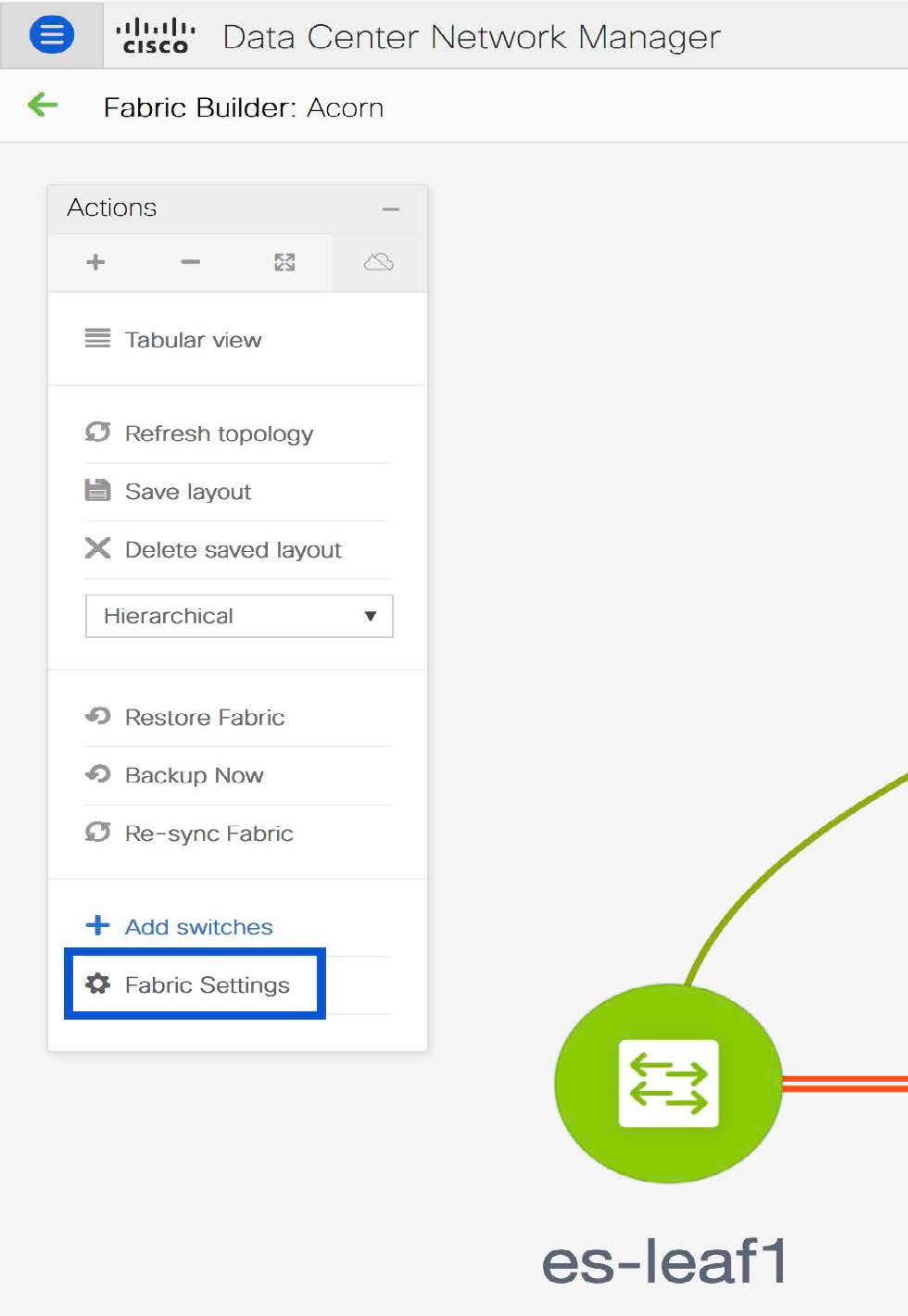
The Edit Fabric window is displayed. Click Advanced. Select the Enable Policy-Based Routing (PBR) checkbox to enable routing of packets based on the specified policy.
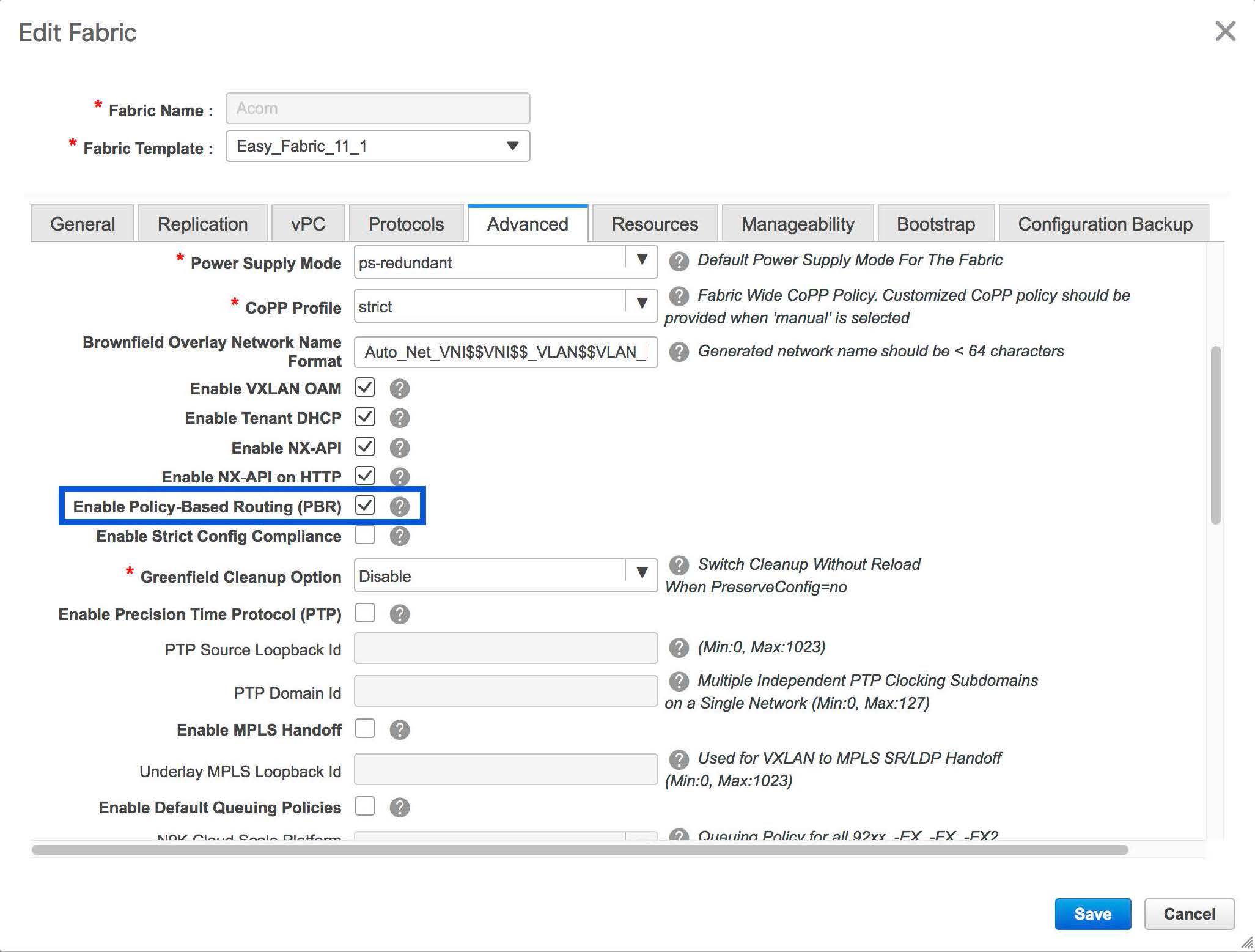
Now, click Resources. Specify a VLAN range in the Service Network VLAN Range field. This is a per switch overlay service network VLAN range. The minimum allowed value is 2 and the maximum allowed value is 3967. Also, specify a value for the Route Map Sequence Number Range field. The minimum allowed value is 1 and the maximum allowed value is 65535. Click Save and Deploy to deploy the updated configuration.
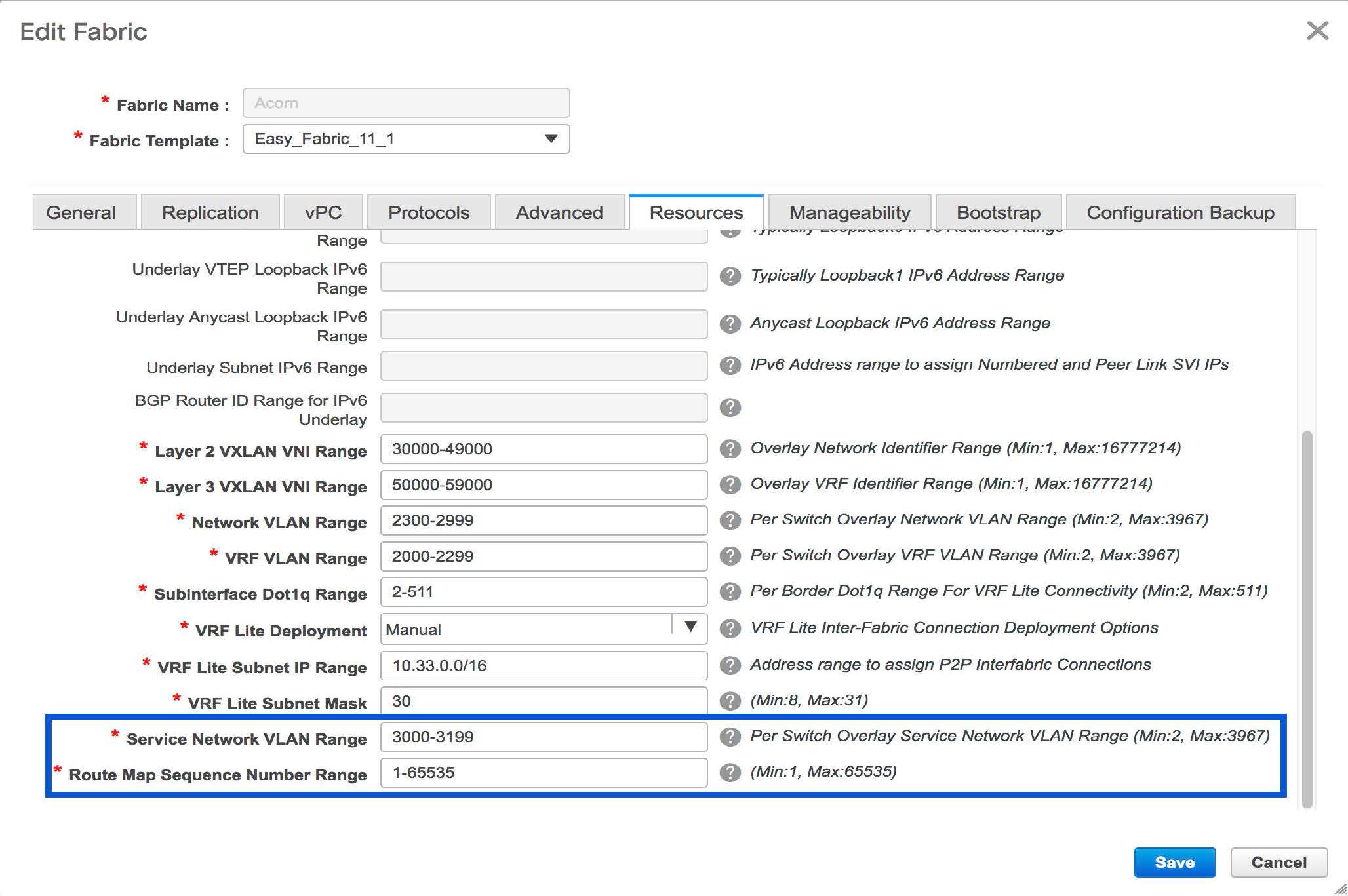
Configuring Layer 4-Layer 7 Service
To launch the L4-L7 Service, or the Elastic Service, on the Cisco DCNM Web UI, choose Control>Fabrics>Services.
The Service Nodes window is displayed. Select a valid switch fabric to display or define the service nodes, route peerings, and service policies, in that fabric.

 Note |
From Cisco DCNM Release 11.5(1), service nodes, route peering, and service policies updated within the last 15 minutes are highlighted. |
The L4-L7 service configuration procedure consists of the following steps:
Create Service Node
To create a service node, click the + icon at the top right of the Service Nodes window to display the New Service Nodes window.

The New Service Nodes window has three steps, Create Service Node, Create Route Peering and Create Service Policy.
The Create Service Node window has two sections - Create Service Node and Switch Attachment, followed by a Link Template drop-down list. You can select service_link_trunk, service_link_port_channel_trunk and service_link_vpc from this drop-down list..
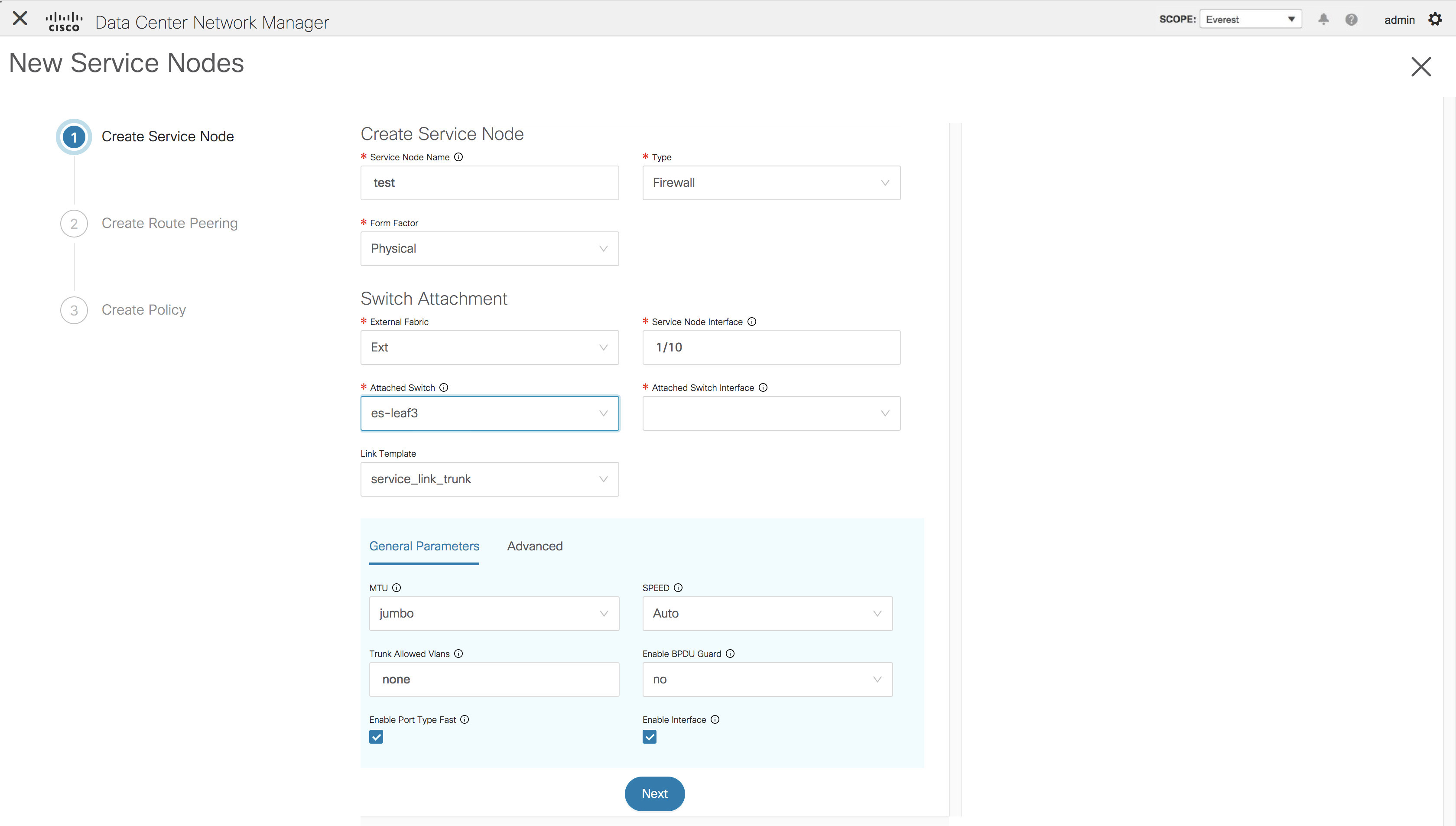

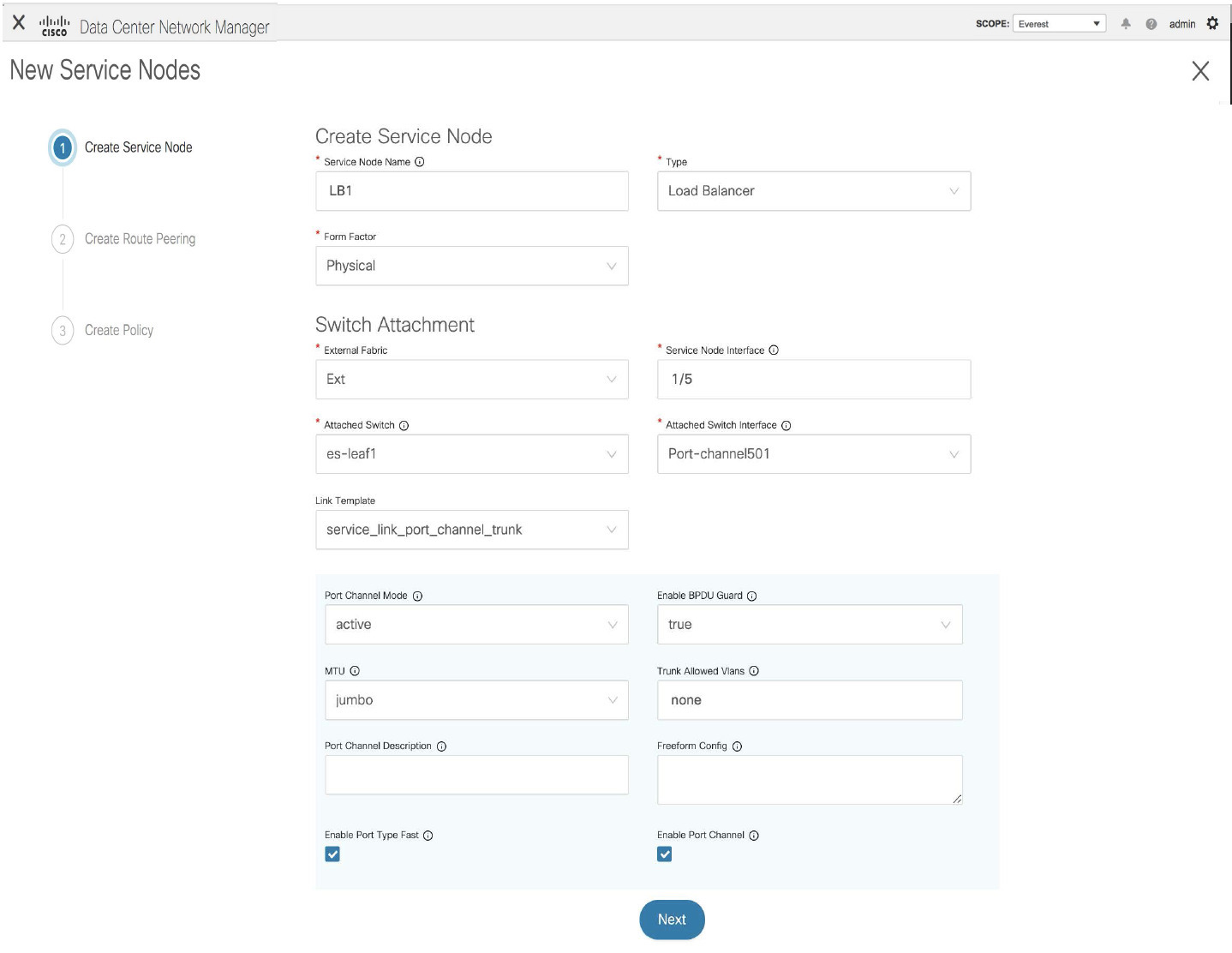

 Note |
From DCNM Release 11.5(1), one-arm Virtual Network Function is supported. |
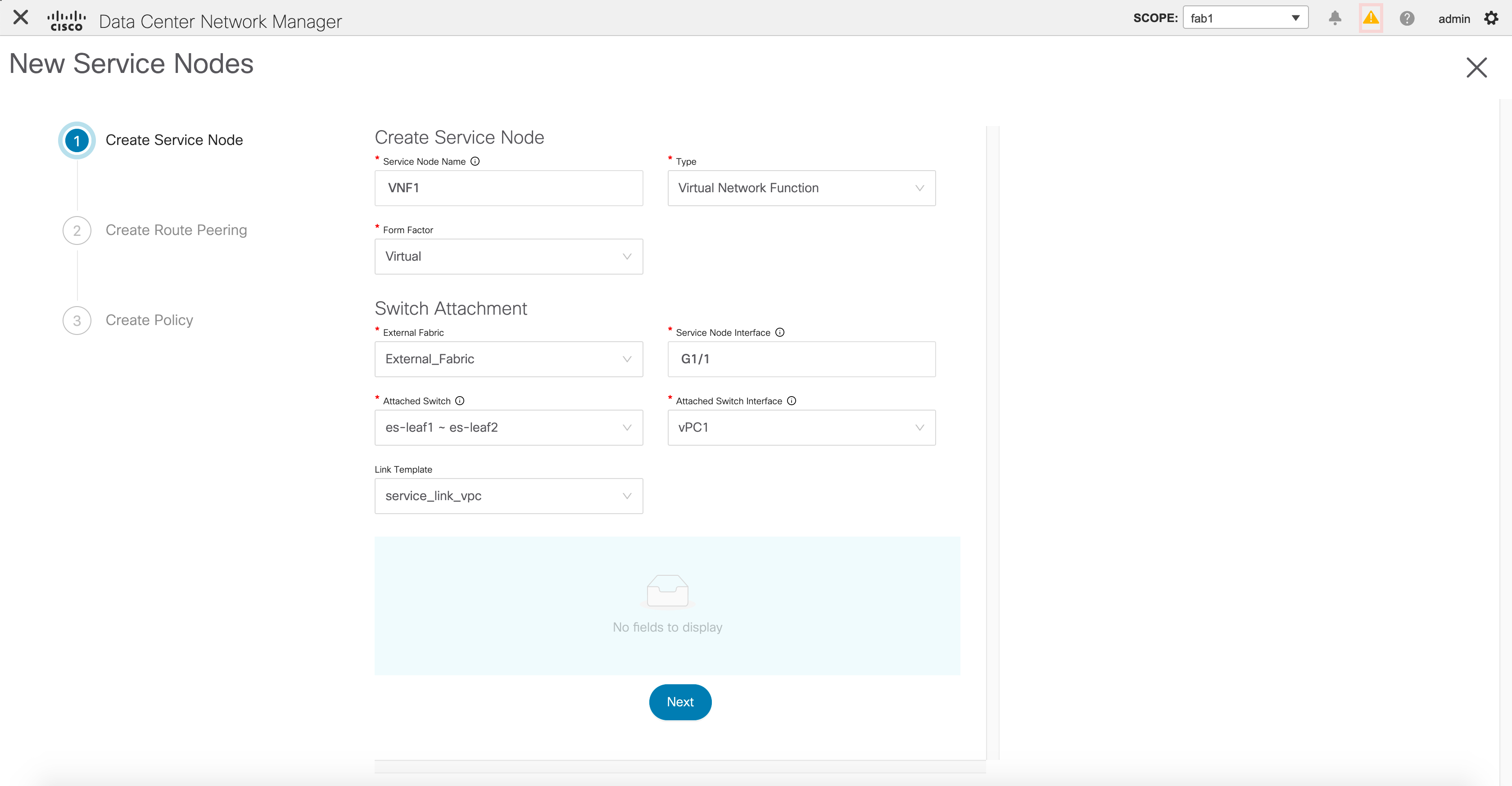
The fields in the Create Service Node window are as given below. It is mandatory to fill the fields marked with an asterisk. For more information on the fields in this window, hover over the i icon.
Create Service Node
Service Node Name - Enter a name for the service node. The name can have alphanumeric, underscore, or dash characters.
Type - Select Firewall or Load Balancer.
Form Factor - Select Physical or Virtual.
Switch Attachment
External Fabric - Specify the external fabric.
Service Node Interface - Specify the service node interface.
Attached Switch- Select a switch from the drop-down list.
Attached Switch Interface - Select the interface from the drop-down list. In case the vPC pair is selected from the Attached Leaf Switch drop-down list, the vPC channel will be shown in the Attached Leaf Switch Interface drop-down list. Otherwise, the port-channel and interfaces with trunk mode are shown in the Attached Leaf Switch Interface drop-down list.
Link Template - Select the service_link_trunk, service_link_port_channel_trunk, or the service_link_vpc template. For more information on template fields, refer Templates.
Now, click Next. A pop-up window is displayed stating that a new service node has been created successfully and the Create Route Peering window is displayed.
Create Route Peering
The fields that appear in the Create Route Peering window depend on the type of deployment chosen in the Create Service Node window. Depending on the type chosen (Firewall or Load Balancer), the types of deployments are Intra-Tenant Firewall, Inter-Tenant Firewall, One-Arm load balancer and Two-Arm load balancer.
 Note |
Deletion of service network is not allowed on the Control > Fabrics > Networks window. |
Example: Intra-Tenant Firewall Deployment
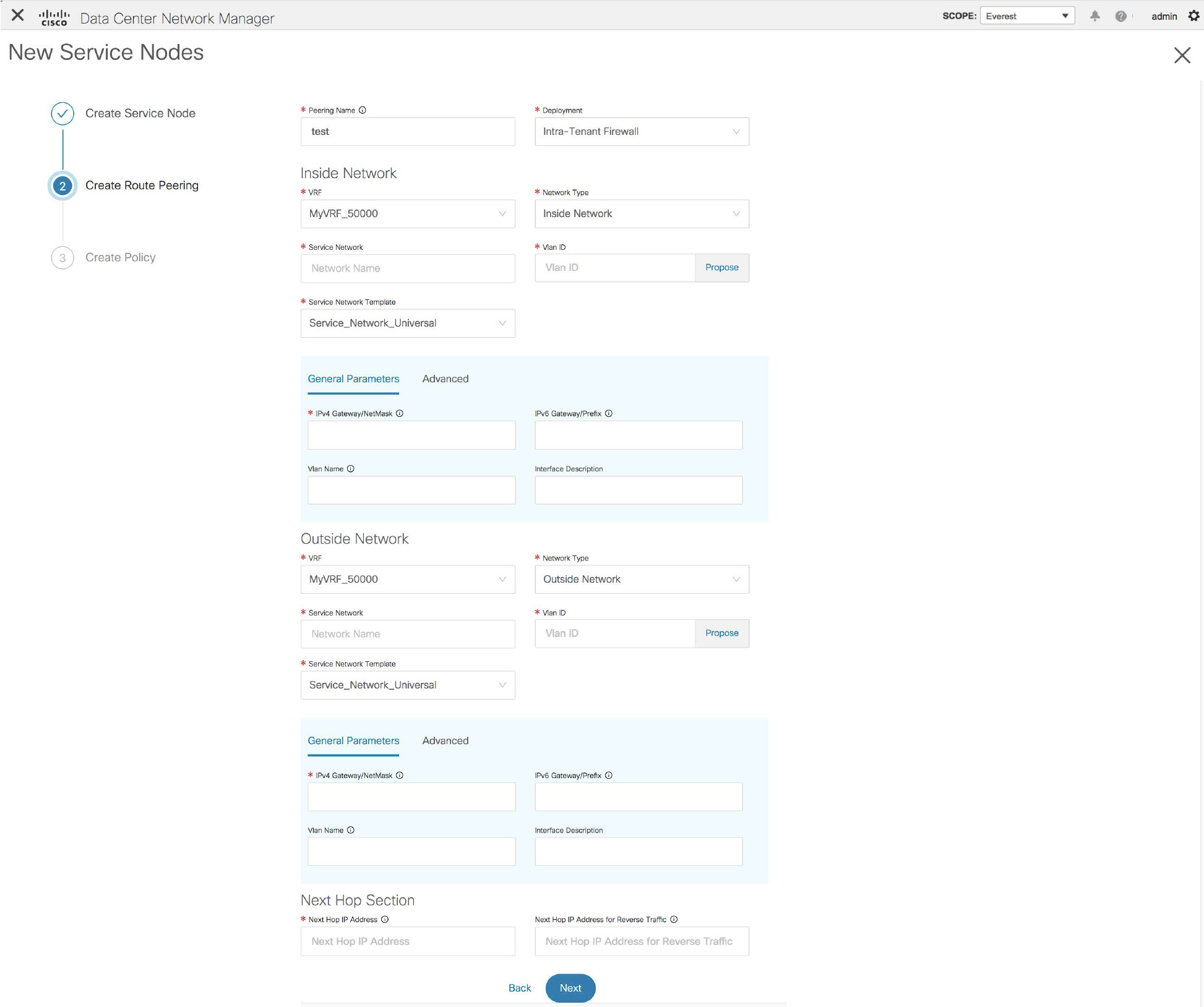
The fields in the Create Route Peering window for an Intra-Tenant Firewall deployment are as given below. It is mandatory to fill the fields marked with an asterisk. For more information on the fields in this window, hover over the i icon.
Peering Name - Specify a name for the peering. The name can have alphanumeric, underscore, or dash characters.
Deployment - Select Intra-Tenant Firewall.
Inside Network
VRF - Specify the VRF.
Network Type - Select Inside Network.
Service Network - Specify the name of the service network.
Vlan ID - Specify the VLAN ID. Valid IDs range from 2 to 3967. Click Propose to retrieve a value from the pre-defined service network VLAN range pool.
Service Network Template - Select the Service_Network_Universal template from the drop-down list. For more information on the template fields, refer Templates.
Outside Network
VRF - Specify the VRF.
Network Type - Select Outside Network.
Service Network - Specify the name of the service network.
Vlan ID - Specify the VLAN ID. Valid IDs range from 2 to 3967. Click Propose to retrieve a value from the pre-defined service network VLAN range pool.
Service Network Template - Select the Service_Network_Universal template from the drop-down list. For more information on the template fields, refer Templates.
Next Hop Section
Next Hop IP Address - Specify the next-hop IP address. This is the IP/VIP of the service node used for traffic redirection.
Next Hop IP Address for Reverse Traffic - Specify the next-hop IP address for reverse traffic. This is the IP/VIP of the service node used for traffic redirection.
Example: Inter-Tenant Firewall Deployment
Peering Option - Static Peering, Inside Network Peering Template - service_static_route, Outside Network Peering Template - service_static_route

The fields in the Create Route Peering window for an Inter-Tenant Firewall deployment are as given below. It is mandatory to fill the fields marked with an asterisk.
Peering Name - Specify a name for the peering. The name can have alphanumeric, underscore, or dash characters.
Deployment - Select Inter-Tenant Firewall.
Peering Option - Select Static Peering or eBGP Dynamic Peering.
Inside Network
VRF - Select a VRF from the drop-down list..
Network Type - Select Inside Network.
Service Network - Select a service network name from the drop-down list.
Vlan ID - Specify the VLAN ID. Valid IDs range from 2 to 3967. Click Propose to retrieve a value from the pre-defined service network VLAN range pool.
Service Network Template - Select the Service_Network_Universal template from the drop-down list. For more information on the template fields, refer Templates.
Peering Template - Select service_static_route or service_ebgp_route from the drop-down list. For more information on the template fields, refer Templates.
Outside Network
VRF - Select a VRF from the drop-down list..
Network Type - Select Outside Network.
Service Network - Select a service network name from the drop-down list.
Vlan ID - Specify the VLAN ID. Valid IDs range from 2 to 3967. Click Propose to retrieve a value from the pre-defined service network VLAN range pool.
Service Network Template - Select the Service_Network_Universal template from the drop-down list. For more information on the template fields, refer Templates.
Peering Template - Select service_static_route or service_ebgp_route from the drop-down list. For more information on the template fields, refer Templates.
Example: One-Arm Mode Load Balancer
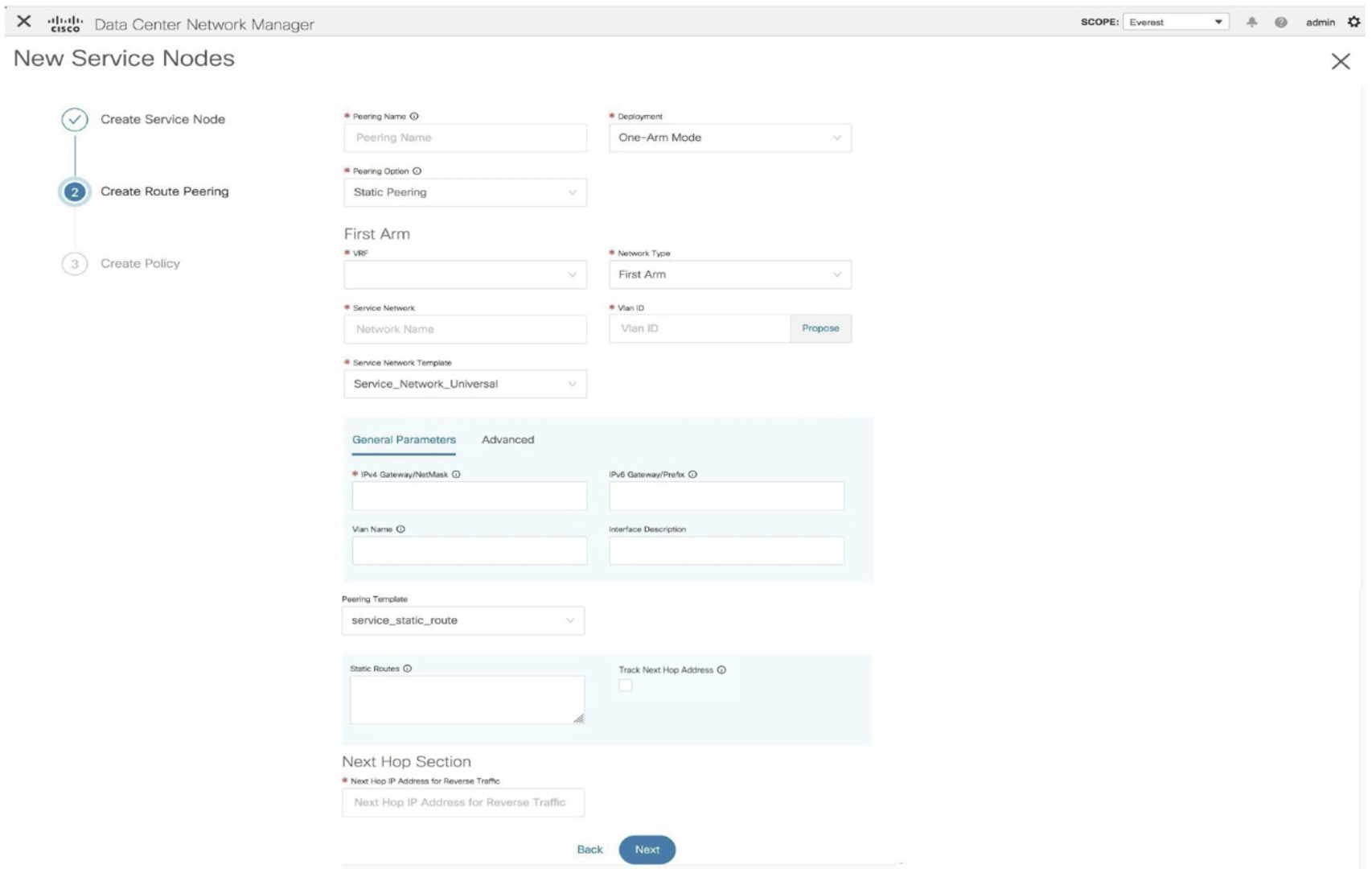
The fields in the Create Route Peering window for a One-Arm Mode load balancer deployment are as given below. It is mandatory to fill the fields marked with an asterisk.
Peering Name - Specify a name for the peering. The name can have alphanumeric, underscore, or dash characters.
Deployment - Select One-Arm Mode.
Peering Option - Select Static Peering or eBGP Dynamic Peering.
First Arm
VRF - Select a VRF from the drop-down list..
Network Type - Select First Arm.
Service Network - Select a service network name from the drop-down list.
Vlan ID - Specify the VLAN ID. Valid IDs range from 2 to 3967. Click Propose to retrieve a value from the pre-defined service network VLAN range pool.
Service Network Template - Select the Service_Network_Universal template from the drop-down list. For more information on the template fields, refer Templates.
Peering Template - Select service_static_route or service_ebgp_route from the drop-down list. For more information on the template fields, refer Templates.
Next Hop IP Address for Reverse Traffic - Specify the next-hop IP address for reverse traffic.
Example: Two-Arm Mode Load Balancer
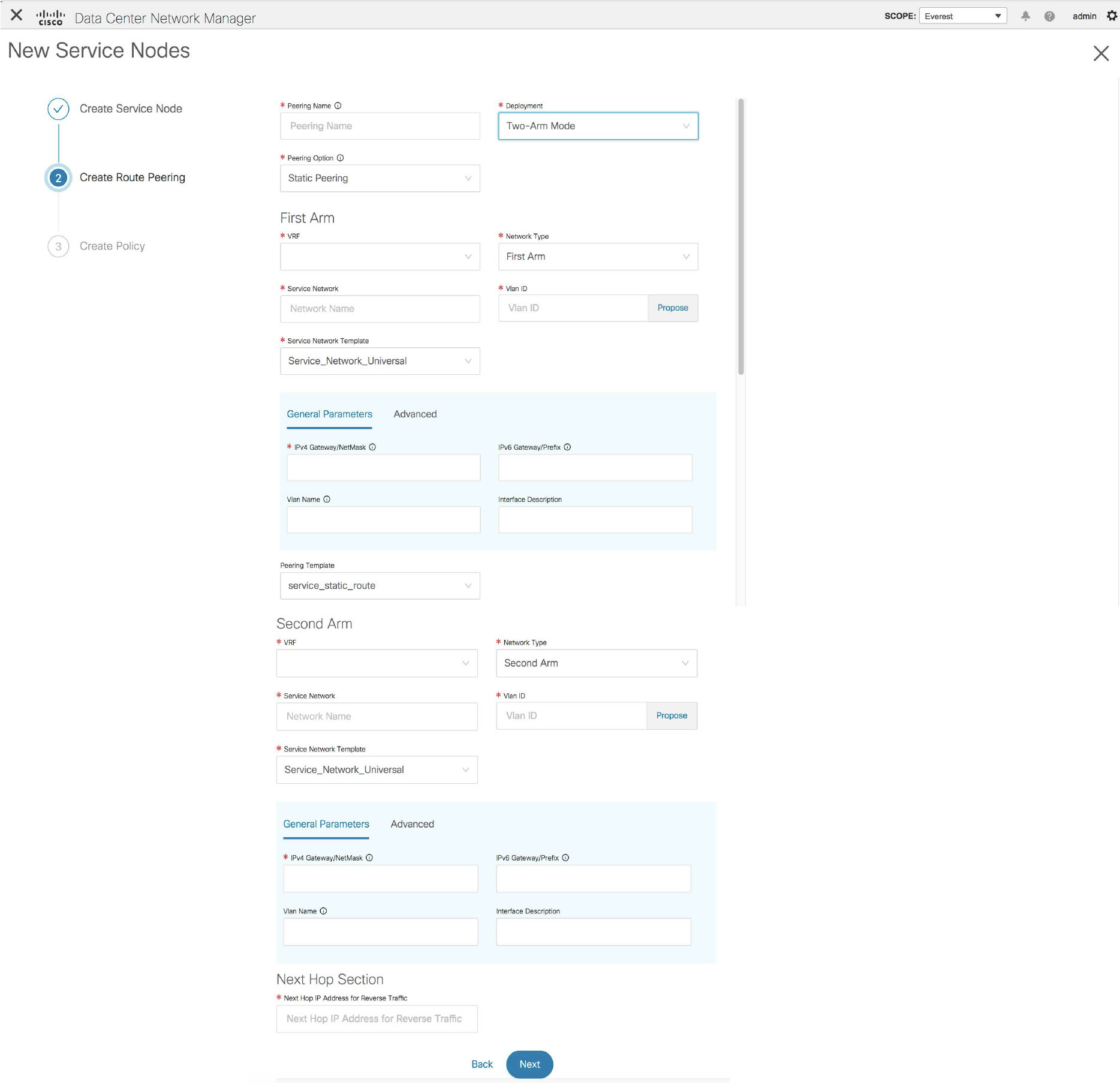
The fields in the Create Route Peering window for a Two-Arm Mode load balancer deployment are as given below. It is mandatory to fill the fields marked with an asterisk.
Peering Name - Specify a name for the peering. The name can have alphanumeric, underscore, or dash characters.
Deployment - Select Two-Arm Mode.
Peering Option - Select Static Peering or eBGP Dynamic Peering.
First Arm
VRF - Select a VRF from the drop-down list..
Network Type - Select First Arm.
Service Network - Select a service network name from the drop-down list.
Vlan ID - Specify the VLAN ID. Valid IDs range from 2 to 3967. Click Propose to retrieve a value from the pre-defined service network VLAN range pool.
Service Network Template - Select the Service_Network_Universal template from the drop-down list. For more information on the template fields, refer Templates.
Peering Template - Select service_static_route or service_ebgp_route from the drop-down list. For more information on the template fields, refer Templates.
Second Arm
VRF - Select a VRF from the drop-down list..
Network Type - Select Second Arm.
Service Network - Specify the name of the service network.
Vlan ID - Specify the VLAN ID. Valid IDs range from 2 to 3967. Click Propose to retrieve a value from the pre-defined service network VLAN range pool.
Service Network Template - Select the Service_Network_Universal template from the drop-down list. For more information on the template fields, refer Templates.
Next Hop Section
Next Hop IP Address for Reverse Traffic - Specify the next-hop IP address for reverse traffic.
Now, click Next. The Create Policy window is displayed.
Example: One-Arm Virtual Network Function
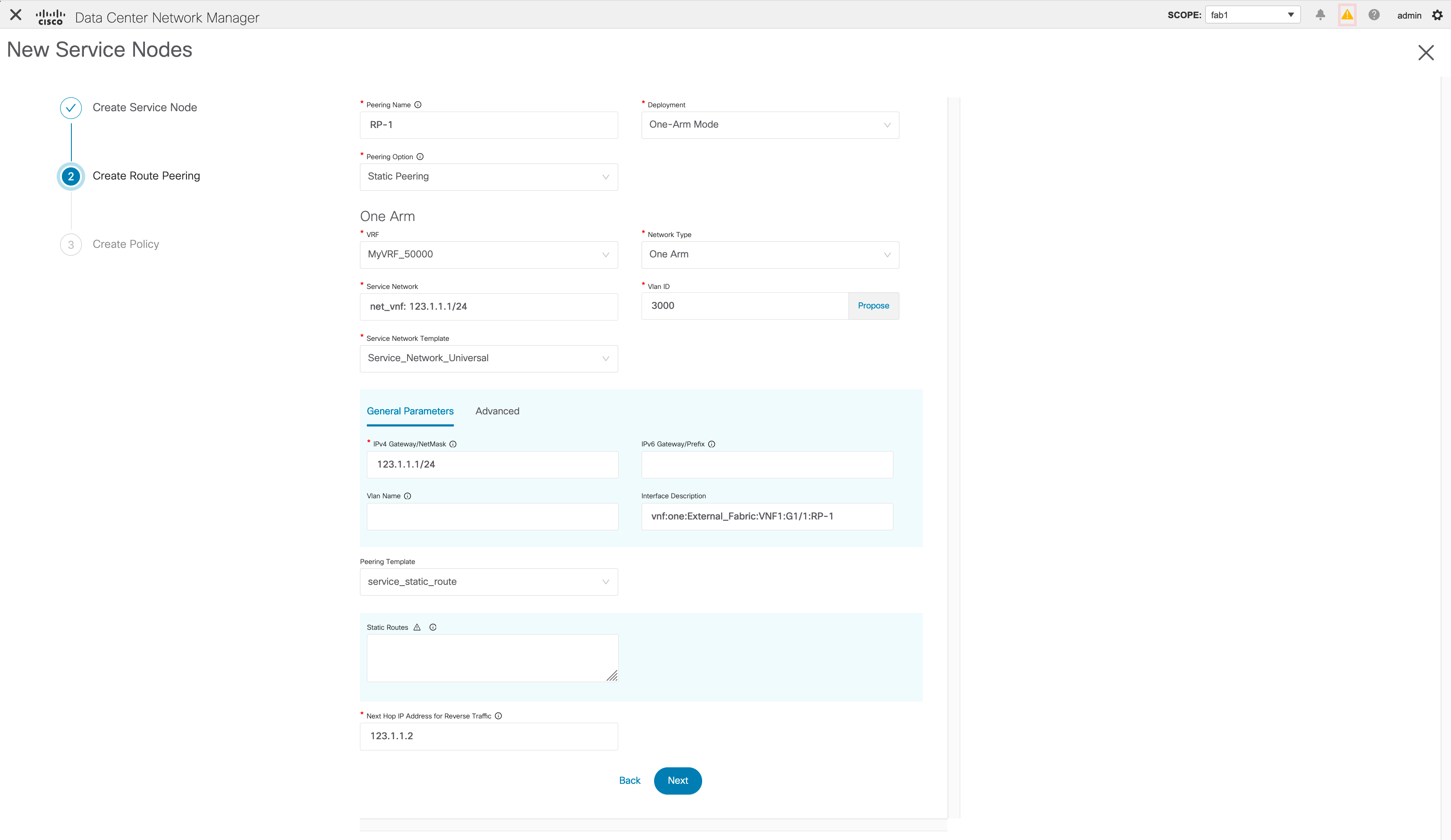

The fields in the Create Route Peering window for a One-Arm Mode Virtual Network Function deployment are as given below. It is mandatory to fill the fields marked with an asterisk.
Peering Name - Specify a name for the peering. The name can have alphanumeric, underscore, or dash characters.
Deployment - Select One-Arm Mode.
Peering Option - Select Static Peering or eBGP Dynamic Peering.
One Arm
VRF - Select a VRF from the drop-down list..
Network Type - Select One Arm.
Service Network - Select a service network name from the drop-down list.
Vlan ID - Specify the VLAN ID. Valid IDs range from 2 to 3967. Click Propose to retrieve a value from the pre-defined service network VLAN range pool.
Service Network Template - Select the Service_Network_Universal template from the drop-down list. For more information on the template fields, refer Templates.
IPv4 Gateway/Netmask - Specify the IPv4 gateway and netmask.
Peering Template - Select service_static_route or service_ebgp_route from the drop-down list. For more information on the template fields, refer Templates.
Next Hop IP Address for Reverse Traffic - Specify the next-hop IP address for reverse traffic.
Now, click Next. The Create Policy window is displayed.
Create Service Policy
The Create Policy window is displayed as given below.

The fields in the Create Policy window are as given below. It is mandatory to fill the fields marked with an asterisk.
Policy Name - Specify a name for the policy.
Peering Name - Select a peering option from the drop-down list.
Source VRF Name - Select a source VRF from the drop-down list.
Destination VRF Name - Select a destination VRF from the drop-down list.
Source Network - Select an IP address from the drop-down list.
Destination Network - Select an IP address from the drop-down list.
Reverse Next Hop IP Address - The reverse next-hop IP address is displayed.
Policy Template Name - Select a template from the drop-down list. For more information on the template fields, refer Templates.
General Parameters
Protocol - Select a protocol from the drop-down list. The options are icmp, ip, tcp, and udp.
Source Port - Specify a source port number. In case the ip protocol is selected, this value is ignored.
Destination Port - Specify a destination port number. In case the ip protocol is selected, this value is ignored.
Starting from Cisco DCNM Release 11.4(1), the Advanced tab has been introduced. The options in this tab allow you to customize the matched traffic redirection. For example, you can specify matched traffic to be redirected using PBR, or for matched traffic to bypass a firewall and use routing table rules instead, or you can specify that any matched traffic has to be dropped. You can choose to override the route map match sequence number for prioritization. You can also customize the ACL name, however ensure that the ACL name that you specify is unique and the same name is not used for another ACL. If you do not specify the route map match sequence number or ACL name, the sequence number will be auto-populated, as in Cisco DCNM Release 11.3(1), from the designated resource pool and the ACL name will be auto-generated based on 5-tuples. For more information on the fields in the Advanced tab, refer Templates.
Click Create. The service policy is created.
 Note |
Deletion of any service network in Top-Down provisioning that is used by Services is not allowed. Deletion of any regular network that is used in a service policy is also not allowed. |
Templates
Service Node Link Templates
service_link_trunk
General Parameters tab
MTU - Specifies the MTU for the interface. By default, this is set to jumbo.
SPEED - Specifies the speed of the interface. By default, this is set to Auto. You can change it to 100Mb, 1Gb, 10GB, 25Gb, 40Gb, or 100Gb, as required.
Trunk Allowed Vlans - Specify 'none',' all' or VLAN ranges. By default, none is specified.
Enable BPDU Guard - Specify an option from the drop-down list. The available options are true, false or no.
Enable Port Type Fast - Select the checkbox to enable spanning tree edge port behavior. By default, this is enabled.
Enable Interface - Uncheck the checkbox to disable the interface. By default, the interface is enabled.
Advanced tab
Source Interface Description - Enter a description for the source interface.
Destination Interface Description - Enter a description for the destination interface.
Source Interface Freeform Config - Enter any addition CLI for the source interface.
Destination Interface Freeform Config - Enter any addition CLI for the destination interface.
service_link_port_channel_trunk
Port Channel Mode - Select a port channel mode from the drop-down list. By default, active is specified.
Enable BPDU Guard - Specify an option from the drop-down list. The available options are true, false or no.
MTU - Specifies the MTU for the interface. By default, this is set to jumbo.
Trunk Allowed Vlans - Specify 'none',' all' or VLAN ranges. By default, none is specified.
Port Channel Description - Enter a description for the port channel.
Freeform Config - Specify the required freeform configuration CLIs.
Enable Port Type Fast - Select the checkbox to enable spanning tree edge port behavior. By default, this is enabled.
Enable Port Channel - Select the checkbox to enable the port channel. By default, this is enabled.
service_link_vpc
This template has no specifiable parameters.
Route Peering Service Network Template
Service_Network_Universal
General Parameters tab
IPv4 Gateway/Netmask - Specify the gateway IP address and mask of the service network.
IPv6 Gateway/Prefix - Specify the gateway IPv6 address and prefix of the service network.
Vlan Name - Specify a name for the VLAN.
Interface Description - Enter a description for the interface
Advanced tab
Routing Tag - Specify a routing tag. Valid values range from 0 to 4294967295.
Route Peering Templates
service_static_route
Enter the static routes in the Static Routes field. You can enter one static route per line.
service_ebgp_route
General Parameters tab
Neighbor IPv4 - Specify the IPv4 address of the neighbor.
Loopback IP - Specify the IP address of the loopback.
Advanced tab
Neighbor IPv6 - Specify the IPv6 address of the neighbor.
Loopback IPv6 - Specify the IPv6 address of the loopback.
Route-Map TAG - Specify route-map tag that is associated with the interface ID.
Interface Description - Enter a description for the interface.
Local ASN - Specify a local ASN to override the system ASN.
Advertise Host Routes - Select the checkbox to enable advertisement of /32 and /128 routes to edge routers.
Enable Interface - Uncheck the checkbox to disable the interface. By default, the interface is enabled.
Service Policy Template
service_pbr
General Parameters tab
Protocol - Select a protocol from the drop-down list. The options are icmp, ip, tcp, and udp.
Source port - Specify a source port number. In case the ip protocol is selected, this value is ignored.
Destination port - Specify a destination port number. In case the ip protocol is selected, this value is ignored.
Advanced tab
Route Map Action - Select an action from the drop-down list. The options are permit or deny. If you select permit, the matched traffic is redirected based on the next-hop option and the defined policy. If you select deny, the traffic is routed based on the routing table rules.
Next Hop Option - Specify an option for the next-hop. The options are none, drop-on-fail, and drop.If you select none, the matched traffic is redirected based on the defined PBR rules. If you select drop-on-fail, the matched traffic is dropped if the specified next hop is not reachable. If you select drop, the matched traffic is dropped.
ACL Name - Specify a name for the generated access control list (ACL). If not specified, this is auto-generated.
ACL Name for reversed traffic - Specify a name for the ACL that is generated for reversed traffic. If not specified, this is auto-generated.
Route map match number - Specify a route map match number. A valid value ranges from 1 to 65535. If not specified, a route map match sequence number will be retrieved from the predefined resource pool. This number is associated with the name of the ACL.
Route map match number for reversed traffic - Specify a route map match number for reversed traffic. A valid value ranges from 1 to 65535. If not specified, a route map match sequence number will be retrieved from the predefined resource pool. This number is associated with the name of the ACL that has been generated for reversed traffic.
You can also customize the templates based on specific requirements. For more information on templates, refer Template Library.
Adding a Route Peering
Procedure
|
Step 1 |
Click the Add Route Peering icon on the Service Nodes window.  |
|
Step 2 |
The Add Route Peering window is displayed.  Specify the required parameters and click Add. For more information on specific fields, hover over the i icon. |
Adding a Service Policy
Procedure
|
Step 1 |
Click the Add Service Policy icon on the Service Nodes window.  |
|
Step 2 |
The Add Service Policy window is displayed.  Specify the required parameters and click Add. For more information on specific fields, hover over the i icon. |
Deleting a Service Node
Procedure
|
Step 1 |
Click the Delete Service Node icon on the Service Nodes window.  |
||
|
Step 2 |
A pop-up window comes up to confirm if the node has to be deleted. Click Delete.
|
Editing a Service Node
Procedure
|
Step 1 |
Click the Edit Service Node icon on the Service Nodes window.  |
|
Step 2 |
The Edit Service Node window is displayed.  Make the required changes and click Save. |
Refreshing the Service Policy and Route Peering List
To refresh the list of service policies or route peerings that is displayed in the Service Nodes window, click the Refresh icon ![]() that appears in the Service Policy tab or the Route Peering tab.
that appears in the Service Policy tab or the Route Peering tab.

Refreshing a Specific Service Policy or Route Peering
From Cisco DCNM Release 11.5(1), click the Refresh icon that appears under the Action column to refresh a specific service policy or route peering.
Attaching a Service Policy or a Route Peering
To attach a specific service policy or route peering from a switch, select the checkbox next to the required service policy or route peering and click Attach.
 Note |
From Cisco DCNM Release 11.5(1), bulk attachment, detachment, preview and deployment of route peering and service policies is supported and they are limited up to 10 route-peerings or 10 service policies only. |

Detaching a Service Policy or a Route Peering
To detach a specific service policy or route peering from a switch, select the checkbox next to the required service policy or route peering and click Detach.

Preview a Service Policy or a Route Peering
Procedure
|
Step 1 |
Select a service policy or route peering checkbox and click Preview on the Service Nodes window.  A Preview Service Policy or a Preview Route Peering window is displayed. 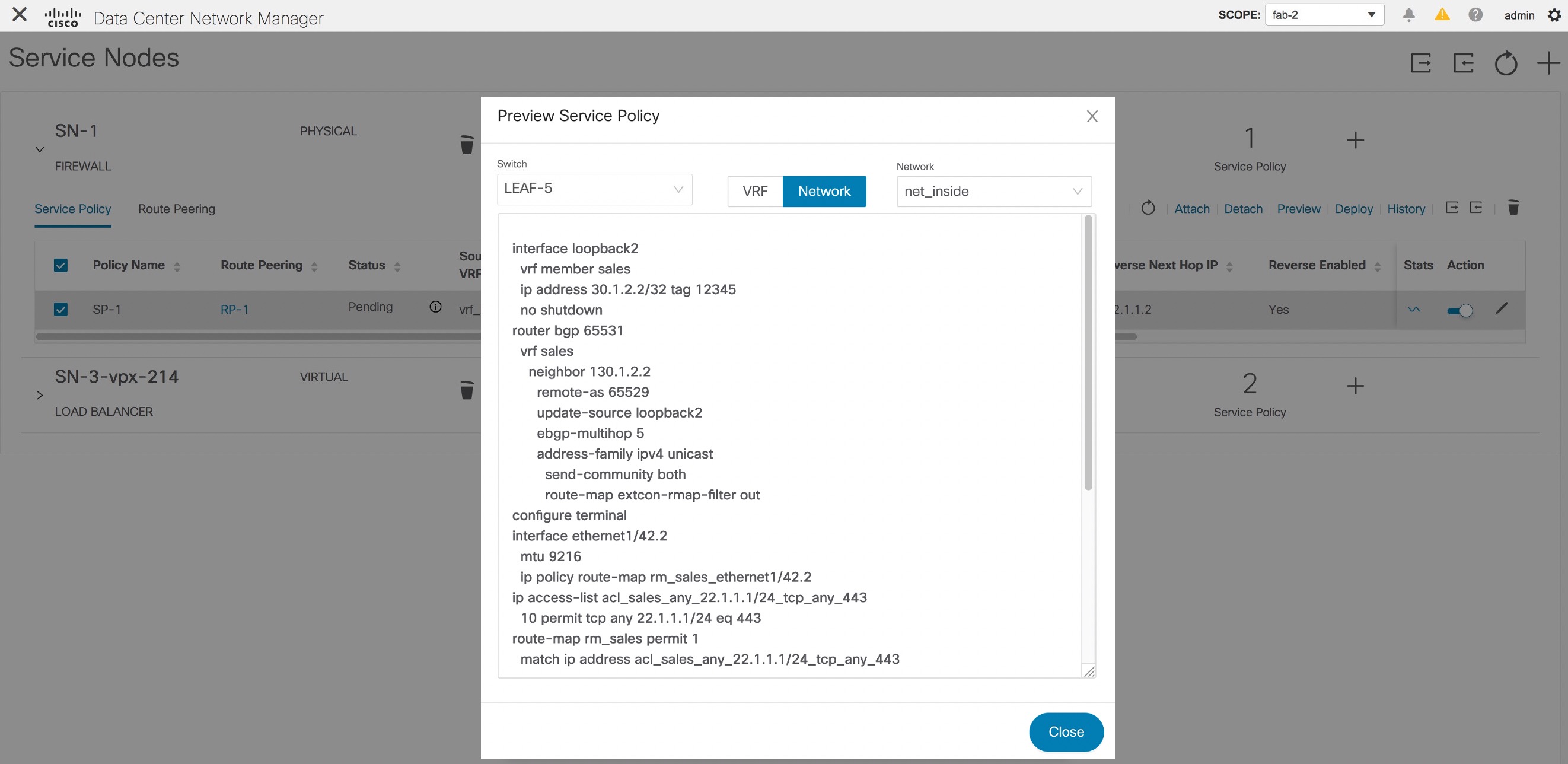 |
|
Step 2 |
Select a specific switch, network, or VRF from the respective drop-down lists to display the service policies or route peerings for specific switches, networks, and VRFs. Click Close to close the window. |
Deploying a Service Policy or a Route Peering
Procedure
|
Step 1 |
Select a service policy or route peering checkbox and click Deploy on the Service Nodes window. A pop-up window is displayed asking for confirmation to deploy.  |
|
Step 2 |
Click Deploy. |
Viewing Deployment History
To view deployment history of the switches and networks that are involved in the selected service policy or route peering, click History in the Service Policy tab or the Route Peering tab. The Deployment History Service Policy or the Deployment History Route Peering window is displayed.

Information such as the name of the network, VRF, and switch, status, status details, and time of execution is displayed.

The first line in the list of CLIs is displayed in the Status Details column. This provides a peak into the deployed configuration. Hover over the i icon next to the Status Details field in each row to display more information.

Select a switch from the Switch dropdown list to display information for the selected switch.

Select a network from the Network dropdown list to display information for the selected network.
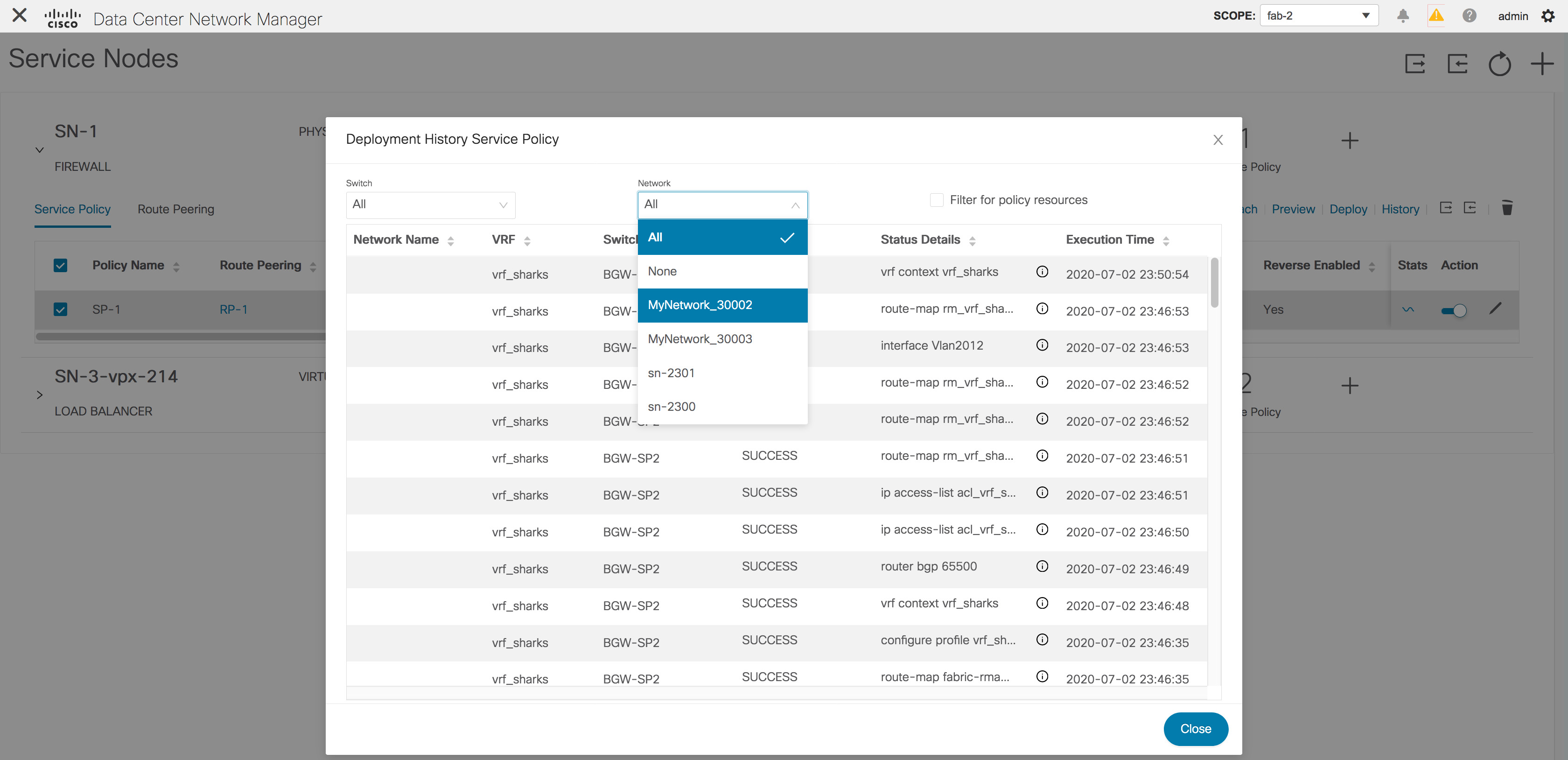
Select the Filter for policy resources checkbox to display only policy-related deployments such as ACLs, route maps and associated CLIs. This checkbox is available only in the Deployment History Service Policy window.

Exporting a Service Policy or a Route Peering Table
To export the service policy or route peering information as an Excel file, click the Export icon on the Service Nodes window. Click the Export icon on the Service Policy tab to export information about the service policies. Click the Export icon on the Route Peering tab to export information about the route peerings.

Importing a Service Policy or a Route Peering Table
To import service policy or route peering information as an Excel file, click the Import icon on the Service Nodes window. Click the Import icon on the Service Policy tab to export information about the service policies. Click the Import icon on the Route Peering tab to export information about the route peerings.

Deleting a Service Policy
Procedure
|
Step 1 |
Select the service policy that has to be deleted by clicking the checkbox that is next to the name of the policy, and then click the Delete icon on the Service Nodes window.  |
|
Step 2 |
A pop-up window is displayed asking for confirmation to delete. Click Delete. In case the service policy that has to be deleted is attached, the pop-up window indicates that the service policy has to be detached by using the toggle in the Action column, and deploying the changes (removing the policy) before it can be deleted.  |
Deleting a Route Peering
Procedure
|
Step 1 |
Select the route peering that has to be deleted by clicking the checkbox that is next to the name of the route peering, and then click the Delete icon on the Service Nodes window.  |
|
Step 2 |
A pop-up window is displayed asking for confirmation to delete. Click Delete. In case the route peering that has to be deleted is attached or if the service policy associated with the route peering is active, the pop-up window indicates that the peering has to be detached by using the toggle in the Action column, deploy the changes (remove the policy), and delete the service policy associated with the route peering before the route peering can be deleted.  |
Viewing Service Policy Information
In the Service Nodes window, the Service Policy tab displays information about the configured service policies.

|
Field |
Description |
|---|---|
|
Policy Name |
Displays the name of the policy. |
|
Route Peering |
Displays the route peering name given for the peering configuration. Click the specified peering name to display route peering information. |
|
Status |
Displays the status of the service policy. |
|
Source VRF |
Displays the Virtual Routing and Forwarding (VRF) source. |
|
Source Network |
Displays the source network. |
|
Destination VRF |
Displays the destination VRF. |
|
Destination Network |
Displays the destination network. |
|
Next Hop IP |
Displays the next-hop IP address. |
|
Reverse Next Hop IP |
Displays the reverse next-hop IP address. |
|
Reverse Enabled |
Displays if reverse next-hop is enabled or not. |
|
Route Map Action |
Displays the specified route map action. |
|
Next Hop Option |
Displays the specified next hop option. |
|
Last Updated |
Displays the time at which the service policy was last updated. |
|
Stats |
Click the graph line to display cumulative statistics for a policy in a specified time range. For more information, refer Stats. |
|
Action |
Use the toggle to enable/attach or disable/detach the service policy. When the service policy is attached or enabled, the corresponding policies are applied to the VRF (tenant), source, and destination networks.  The toggle turns blue in color when the service policy is attached or enabled.  Click the Edit icon to edit the service policy. 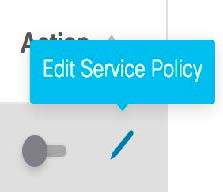 |
Stats
In the Service Nodes window, the Service Policy tab displays statistical information about the configured service policies. Select a time range for which the statistics should be displayed from the Time Range drop-down box. You can select the date from the calendar displayed on the window and the time by clicking select time at the bottom right corner of the window. You can also display statistics from the last 15 minutes, 1 hour, 6 hours, 1 day, and 1 week. Select the required time range and click Apply. Select a switch for which the statistics should be displayed from the Switch drop-down list. The statistics are then displayed for the selected switch in the specified time range. Starting from Cisco DCNM Release 11.4(1), you can click Clear Stats to reset the statistics for a specific policy on all involved switches. If multiple policies are sharing the same route map, then the statistics of other policies are also impacted.
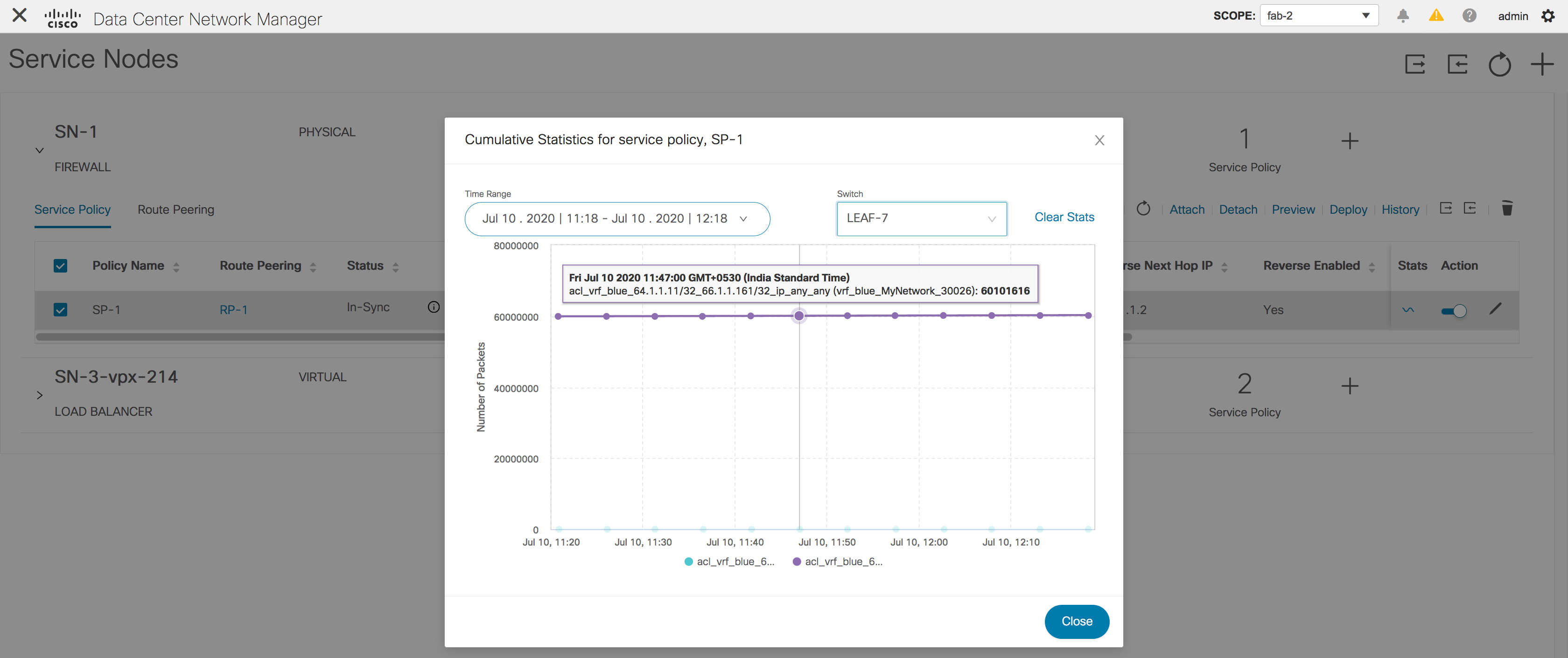
Viewing Route Peering Information
In the Service Nodes window, click Route Peering. The Route Peering tab displays route peering information.

|
Field |
Description |
|---|---|
|
Peering Name |
Displays the defined peering name. |
|
Deployment |
Displays the deployment - One-Arm mode or Two-Arm mode. |
|
Peering Option |
Displays the peering option - Static or eBGP Dynamic peering. |
|
Status |
Displays the status of the route peering. |
|
Service Network VRF |
Displays the service network VRF. |
|
Service Network Name |
Displays the name of the service network. |
|
Service Network Gateway IP |
Displays the gateway IP of the service network VRF. |
|
Next Hop IP |
Displays the next-hop IP address. |
|
Reverse Next Hop IP |
Displays the reverse next-hop IP address. |
|
Last Updated |
Displays the time at which the route peering was last updated. |
|
Action |
Use the toggle to enable/attach or disable/detach the route peering. When the route peering is enabled, the service networks defined in that route peering will be attached to the service leaf.  The toggle turns blue in color when the route peering is attached or enabled.  Click the Edit icon to edit the route peering. 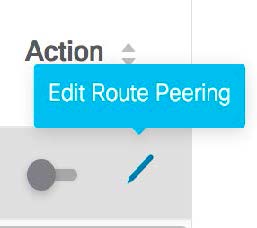 |
Service Node Backup and Restore
You can back up data at the service node level by clicking the Export icon ![]() to export data about the service nodes to an excel file. Data regarding all the service nodes, the respective route peerings
and service policy, is exported.
to export data about the service nodes to an excel file. Data regarding all the service nodes, the respective route peerings
and service policy, is exported.
You can also restore the service node level data by clicking the Import icon ![]() to import data about the service nodes from an excel file.
to import data about the service nodes from an excel file.

You can also export data for a specific service node by clicking the Export icon ![]() located next to the Edit Service Node icon.
located next to the Edit Service Node icon.

Fabric Backup and Restore
During easy fabric and parent MSD fabric backup, the service node connections, route peering and service policy configurations, such as composed ACL and route-map, are saved as part of the fabric, VRF and the tenant network intent. However, the definitions of service node, route peering and service policy are not saved. We recommend backing up the service data by clicking the Export icon at the service node level from the Control > Services window. While restoring easy fabrics and parent MSD fabrics, the service data can be restored by clicking the Import icon at the service node level from the Control > Services window. The service node connections, route peering and service policy configuration will be restored along with the associated fabric, VRF and the tenant network intent.
Brownfield Migration
During brownfield migration, the L4-L7 service configuration, such as ACLs and route-maps associated with networks and VRFs, are captured in the switch freeform policy linked to the tenant network and the VRF profile. No service node, route peering, or service policy is auto-generated as a result of brownfield migration. If you want to apply a new service policy to the same tenant network or VRF, remove the captured freeform configuration and configuration compliance will then generate the required CLIs that you can deploy later.
Audit History
From Cisco DCNM Release 11.5(1), click the Audit icon on the Service Nodes window to display the Audit History window.

The Audit Logs table in the Audit History window displays information about all the actions that have been performed. Audit logs are generated when the following actions are performed:
-
Creation of service nodes, route peering and service policies
-
Deletion of service nodes, route peering and service policies
-
Update of service nodes, route peering and service policies
-
Attachment and detachment of route peering and service policies
-
Deployment of route peering and service policies
This audit log is saved with the name of the user who has performed the action, the role of the user, the action taken, the entity on which the action was performed, details about the action, the status, and the time at which the action was performed.
To perform a search in each column, click the search icon in the required column and enter the search string.
To display more information about each row, click the + icon next to the user name.

To export the data on this window to an Excel file, click the Export icon.

To selectively hide or show fields from the Audit Logs table, click the gear icon that is located next to the export icon to select the fields that have to be displayed in the Audit Logs table.
To delete older audit reports, click the icon, specify the maximum retained dates and confirm deletion. Note that only users with the admin role can delete audit log entries.
To display the latest audit log, click the Refresh icon that is located above the Audit Logs table.

 Feedback
Feedback